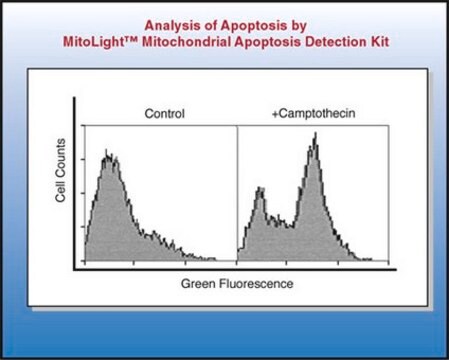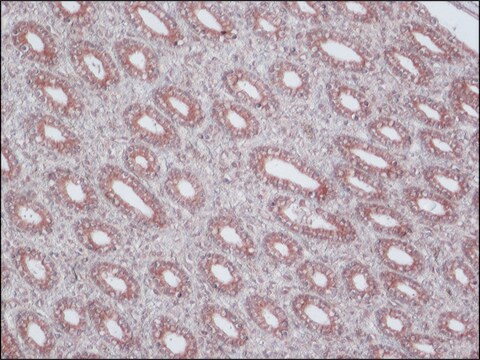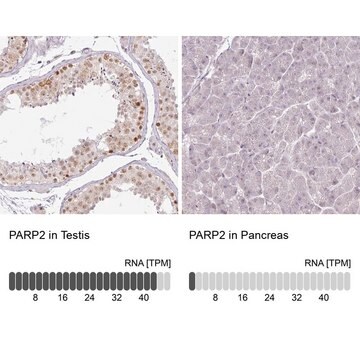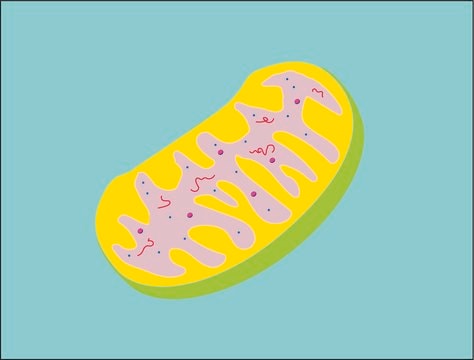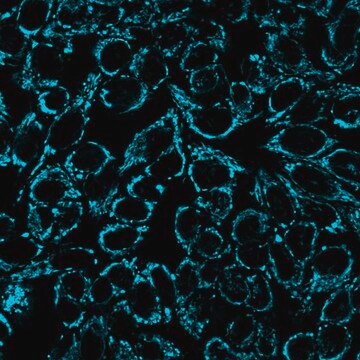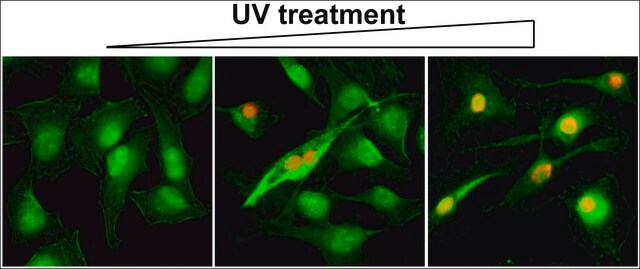APT242
MitoLight Mitochondrial Apoptosis Detection Kit
The MitoLight Apoptosis Detection Kit for flow cytometry utilizes a lipophilic cation, termed as MitoLight, as a mitochondrial activity marker.
Anmeldenzur Ansicht organisationsspezifischer und vertraglich vereinbarter Preise
Alle Fotos(1)
About This Item
UNSPSC-Code:
12161503
eCl@ss:
32161000
NACRES:
NA.32
Empfohlene Produkte
Qualitätsniveau
Hersteller/Markenname
Chemicon®
MitoLight
Methode(n)
flow cytometry: suitable
Nachweisverfahren
fluorometric
Versandbedingung
dry ice
Allgemeine Beschreibung
Disruption of the mitochondrial transmembrane potential is one of the earliest intracellular events that occur following induction of apoptosis. The MitoLight Apoptosis Detection Kit utilizes a lipophilic cation, termed as MitoLight, as a mitochondrial activity marker. MitoLight is a mitochondrial dye that stains mitochondria in living cells in a membrane potential-dependent fashion. The monomer is in equilibrium with so-called J-aggregates, which are favored at higher dye concentration or higher mitochondrial membrane potential.
MitoLight partitions differently in healthy cells than in apoptotic cells. Therefore, it has been possible to use a fluorescence ratioing technique to study mitochondrial membrane potentials. In healthy cells, the dye accumulates and aggregates in the mitochondria, giving off a bright red fluorescence (λem = 585-590 nm). In apoptotic cells with altered mitochondrial membrane potential, the dye in its monomeric form stays in the cytoplasm, fluorescing green (λem = 527-530 nm), providing a ready discrimination between apoptotic and nonapoptotic cells. The fluorescence can be observed by fluorescence microscopy using a band-pass filter (detects FITC and rhodamine) or analyzed by flow cytometry using FITC channel for green monomers (Ex/Em = 488/530) and PI channel for red aggregates (Ex/Em = 488/585).
MitoLight partitions differently in healthy cells than in apoptotic cells. Therefore, it has been possible to use a fluorescence ratioing technique to study mitochondrial membrane potentials. In healthy cells, the dye accumulates and aggregates in the mitochondria, giving off a bright red fluorescence (λem = 585-590 nm). In apoptotic cells with altered mitochondrial membrane potential, the dye in its monomeric form stays in the cytoplasm, fluorescing green (λem = 527-530 nm), providing a ready discrimination between apoptotic and nonapoptotic cells. The fluorescence can be observed by fluorescence microscopy using a band-pass filter (detects FITC and rhodamine) or analyzed by flow cytometry using FITC channel for green monomers (Ex/Em = 488/530) and PI channel for red aggregates (Ex/Em = 488/585).
Anwendung
Research Category
Apoptose & Krebs
Apoptose & Krebs
The MitoLight Apoptosis Detection Kit for flow cytometry utilizes a lipophilic cation, termed as MitoLight, as a mitochondrial activity marker.
Komponenten
MitoLight (Part No. 71616): 100 μL in DMSO.
10X Incubation Buffer (Part No. 71614): 20 mL.
10X Incubation Buffer (Part No. 71614): 20 mL.
Lagerung und Haltbarkeit
Store kit materials at -20°C up to their expiration date. After thawing, unused kit components can be refrozen. For best results, aliquot the MitoLight reagent into separate vials to avoid repeated freeze/thaw cycles.
PROTECT REAGENTS FROM LIGHT.
PROTECT REAGENTS FROM LIGHT.
Rechtliche Hinweise
CHEMICON is a registered trademark of Merck KGaA, Darmstadt, Germany
Haftungsausschluss
Unless otherwise stated in our catalog or other company documentation accompanying the product(s), our products are intended for research use only and are not to be used for any other purpose, which includes but is not limited to, unauthorized commercial uses, in vitro diagnostic uses, ex vivo or in vivo therapeutic uses or any type of consumption or application to humans or animals.
Lagerklassenschlüssel
10 - Combustible liquids
Analysenzertifikate (COA)
Suchen Sie nach Analysenzertifikate (COA), indem Sie die Lot-/Chargennummer des Produkts eingeben. Lot- und Chargennummern sind auf dem Produktetikett hinter den Wörtern ‘Lot’ oder ‘Batch’ (Lot oder Charge) zu finden.
Besitzen Sie dieses Produkt bereits?
In der Dokumentenbibliothek finden Sie die Dokumentation zu den Produkten, die Sie kürzlich erworben haben.
Unser Team von Wissenschaftlern verfügt über Erfahrung in allen Forschungsbereichen einschließlich Life Science, Materialwissenschaften, chemischer Synthese, Chromatographie, Analytik und vielen mehr..
Setzen Sie sich mit dem technischen Dienst in Verbindung.